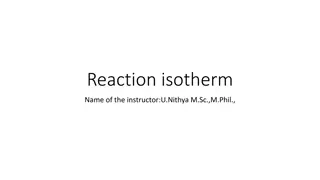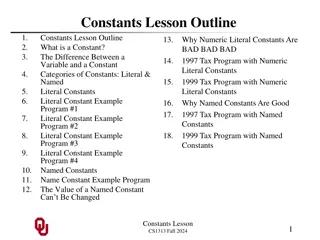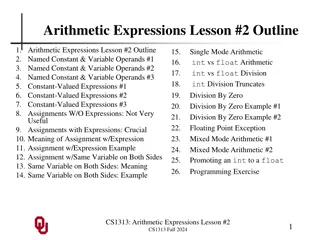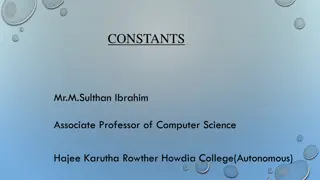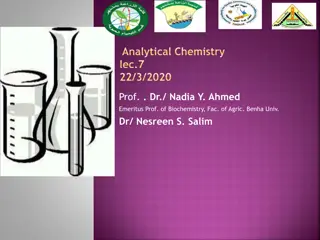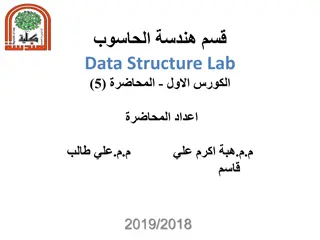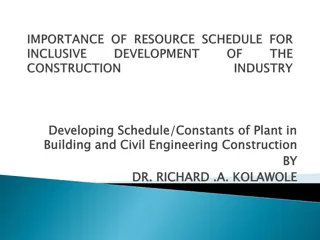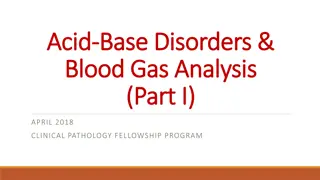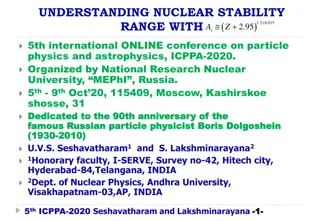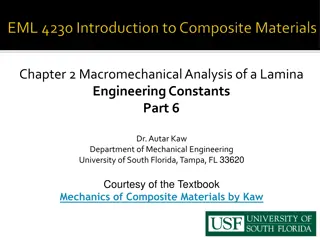Programming in C: Overview and Constants Explanation
Programming in C is a fundamental introductory guide to the C programming language. It covers the basics of C, including its development history, character set, constants, and rules for constructing constants like integer and real constants. Dr. M. A. JAMAL MOHAMED YASEEN ZUBEIR, an Assistant Profes
6 views • 33 slides
Reaction Isotherms and Equilibrium Constants
Explore reaction isotherms and equilibrium constants through Vant Hoff's and Gibbs free energy equations. Learn about the relationship between Gibbs free energy, equilibrium constant, and temperature dependence. Discover how these concepts are applied in determining the direction of chemical reactio
3 views • 18 slides
Assembler Directives and Symbols in Assembly Language
Assembly language is a low-level programming language used for computers, microprocessors, microcontrollers, and ICs. It consists of instructions and directives (pseudo instructions). Assembler directives are statements that guide the assembler during the assembly process. Categories of directives i
15 views • 39 slides
Algebraic Expressions: Variables, Coefficients, and Constants
Explore the difference between numeric and algebraic expressions, learn about the components of algebraic expressions - variables, coefficients, and constants. Discover how to identify variables, coefficients, and constants in expressions. Classify algebraic expressions as monomials, binomials, or t
1 views • 20 slides
Lattice Constants in Materials Using DFT Calculations
Using Density Functional Theory (DFT) calculations, we explore how to determine the lattice constant of simple cubic, face-centered cubic (fcc), and hexagonal close-packed (hcp) materials. By fitting numerical data and analyzing energy considerations, we predict lattice constants for various metal s
2 views • 17 slides
Introduction to Floating Point Data Types and Operations
This content delves into the fundamentals of floating-point data types, focusing on single-precision floating-point formats like float, excess-127, and their characteristics. It also compares float and int32_t data types, detailing the representation and conversion of values between them. The materi
4 views • 46 slides
Chemistry Review Exercise: Periodic Table and Atomic Properties Review
This detailed content covers a review exercise on the Periodic Table and Atomic Properties of various elements. It includes information on atomic structures, fundamental physical constants, and common elements found in the Periodic Table. The content explores elements from Hydrogen to Osmium, detail
3 views • 16 slides
Constants in Programming
Constants in programming are values that remain fixed throughout the execution of a program, unlike variables whose values can change. This lesson outline covers the definition of constants, the difference between variables and constants, categories of constants (literal and named), examples of lite
4 views • 18 slides
Java Programming Concepts: Data, Loops, Variables, and Scope
This content discusses fundamental Java programming concepts such as primitive data types, definite loops, constants, scope, limitations of variables, and scope implications. It also covers the use of class constants to create fixed values visible throughout a Java program.
1 views • 15 slides
Arithmetic Expressions and Constants in Programming
Learn about the importance of named constants and variables in arithmetic expressions, how to perform assignments with and without expressions, and the implications of working with integer and floating-point arithmetic in programming. Explore examples and exercises to enhance your programming skills
5 views • 26 slides
Different Types of Constants in Programming
Constants in programming are fixed values that do not change during program execution. They include character, numerical, and string constants. Integer constants can be decimal, octal, or hexadecimal. This article explains each type of constant with examples of decimal, octal, and hexadecimal intege
2 views • 22 slides
Precipitation Reactions in Analytical Chemistry
Precipitation reactions play a crucial role in analytical chemistry, where cations and anions combine to form insoluble solids called precipitates. By following solubility rules, scientists can predict these reactions, aiding in identifying ions present in solutions. Properties, formation, and equil
0 views • 17 slides
Constants and Literals in C++ Programming
Constants and literals in C++ are fixed values that the program cannot alter. They come in various types such as integer numerals, floating-point numerals, characters, strings, and boolean values. Integer literals can be decimal, octal, or hexadecimal constants, while floating-point literals have in
3 views • 7 slides
Numeric Data Types in Programming
Exploring the world of numeric data types, this content delves into the concepts of integers and real numbers in mathematics as well as their representation in computing. It covers the use of literal constants, named constants, and the differences between integers and real numbers. The content also
3 views • 42 slides
Plant Constants in Construction Engineering
This academic piece delves into the significance of plant constants in building and civil engineering construction projects. It discusses the necessity of accurate quotes, reliable quantities, and standards for labor and plant to achieve efficiency and cost-effectiveness. The content emphasizes the
1 views • 19 slides
Acid-Base Disorders and Blood Gas Analysis
This educational content provides definitions, formulas, and explanations related to acid-base disorders, blood gas analysis, dissociation constants, the Henderson-Hasselbalch equation, and carbonic acid in clinical pathology. Learn about acids, bases, pH, ionization constants, and how these concept
6 views • 35 slides
Julia Language 1.0 Ephemeris and Physical Constants Reader for Solar System Bodies Asteroid Shape Modeling
Advancements in Julia Language with a focus on ephemeris and physical constants reader for solar system bodies, specifically asteroid shape modeling. This cutting-edge technology, developed by Julia Mihaylov from Embry-Riddle Aeronautical University, offers valuable insights into asteroid research,
3 views • 12 slides
Fundamental Principles of Metrology: Units, Derived Units, and Constants
In this discussion, delve into the world of metrology focusing on base SI units, derived units, common SI measurements, and fundamental constants. Explore the significance of measurements in fields such as electrical metrology and understand the role of physical forces in establishing units of measu
3 views • 49 slides
Planetary Constants Kernel (PCK) Subsystem
The Planetary Constants Kernel (PCK) subsystem includes text and binary kernels for providing orientation and shape models for celestial bodies in the solar system. Text PCKs offer data on size, shape, and orientation, while binary PCKs are used when high accuracy orientation data is available. Lear
1 views • 18 slides
Coupling Constants in NMR Spectroscopy
Coupling constants play a vital role in NMR spectroscopy by indicating the distance between peaks in a multiplet, reflecting how neighboring nuclei affect each other's spin states. They are expressed in Hertz and remain constant regardless of the operating frequency. This leads to the observation of
7 views • 19 slides
Exploring Nuclear Stability Range and Unification Models at ICPPA-2020
Discover the inadequacy of current mass formulae in nuclear physics, delve into the secrets of nuclear binding energy and magic numbers, and explore the 4G model of final unification presented at the 5th International Online Conference on Particle Physics and Astrophysics (ICPPA-2020). Gain insights
3 views • 25 slides
Macromechanical Analysis of a Lamina Engineering Constants
Explore the application of stresses to find engineering constants of an angle lamina in the field of composite materials engineering, as presented by Dr. Autar Kaw from the University of South Florida. This detailed analysis covers various aspects of lamina behavior and properties.
1 views • 14 slides
Exploring the Fascinating World of Modern Physics
Dive into the realm of modern physics, encompassing the revolutionary theories of relativity and quantum mechanics. Discover the evolution from classical physics to the specialized fields like mechanics, thermal physics, wave motion, electricity, and more. Uncover the significance of Newtonian mecha
2 views • 12 slides
Analysis of Rate Data for Determining Reaction Order and Rate Constants
Explore methods such as the Method of Half-lives and Initial Rates for analyzing rate data to determine reaction order and specific rate constants. Various experimental techniques and reaction kinetics are discussed, providing insights into reaction mechanisms under different conditions.
4 views • 24 slides
Algebraic Expressions: Understanding Variables, Coefficients, Terms, and Constants
Learn about algebraic expressions, variables, coefficients, terms, and constants. Discover how to identify and work with these components in mathematical expressions. Practice writing algebraic expressions from word phrases. Enhance your understanding of algebraic concepts.
1 views • 15 slides
Nonlinear Regression Models and Constants
From exponential to power models, this content explores various nonlinear regression models and the process of finding constants for them. The focus is on understanding the relationships between data pairs and fitting the best model to the given data. The discussion includes techniques like differen
0 views • 56 slides
Reducing Coupled Differential Equations for Suspension System Modeling
Modeling a suspension system of a bus involves deriving differential equations to represent the system's behavior. This task requires an understanding of vibrations theory and mathematical techniques. The equations govern the behavior of the suspension mass, spring constants, damping constants, and
0 views • 22 slides
Structs in Rust: Overview and Implementation
Learn about structs in Rust, which organize related data, methods, and constants into types. Understand the different kinds of structs available and how to work with associated functions, constants, and generic structs. Explore deriving traits for structs and practical exercises for declaring and us
2 views • 6 slides
Assembler Directives and Language Overview
Discover the fundamentals of assembly language, including assembler directives, symbols, variables, constants, and data definition directives. Learn about the categories of assembler directives and the significance of symbols in assembly language programming. Understand the rules for variable names
2 views • 39 slides
JavaScript Constants and Scope in MIS 2402 Department at Temple University
Explore the concept of JavaScript constants and different scopes in the MIS 2402 Department at Temple University. Learn how to declare variables using let and const, understand global, function-level, and block-level scopes, and discover the importance of defining constants for data control in your
2 views • 16 slides
Introduction to C Programming: History, Character Set, Constants, Variables, Keywords
Discover the history of C programming language introduced by Bell Laboratories in 1972. Learn about the character set, constants, variables, and keywords in C programming. Understand the rules for constructing variable names and how keywords are reserved in C.
1 views • 6 slides
Chemical Equilibrium Concepts & Equilibrium Constants
This content delves into chemical equilibrium, examining the concept, graphical representation, equilibrium constant expression, and examples related to equilibrium constants like Kc and Kp. It also covers mass action rules governing forward and reverse directions. The relationship between Kp and Kc
3 views • 43 slides
Understanding Reaction Isotherms and Equilibrium Constants
Explore the relationship between Gibbs free energy, equilibrium constants, and reaction isotherms. Learn how to derive Vant Hoff's equation and analyze the temperature dependence of equilibrium constants. Applications of these concepts in determining reaction direction and calculating free energy ar
7 views • 18 slides
Understanding Tokens, Identifiers, Constants, and Data Types in C
Learn about the fundamental elements of the C programming language, including tokens, identifiers, constants, and basic data types like integral and floating-point values. Explore rules for naming variables and grasp the essential concepts for effective C programming.
3 views • 16 slides
Spin Glass Dynamics in Random Systems: Mesoscale Insights
Explore the phenomena of spin glass dynamics in random and complex systems at the mesoscale level, examining growth patterns, relaxation dynamics, and sample preparation of amorphous Ge:Mn. Discover key determinants such as time constants, barrier heights, and critical crossover times, shedding ligh
3 views • 24 slides
Understanding Java Interfaces: Constants, Extending, Implementing
Learn about Java interfaces, including handling empty interfaces, constants, extending interfaces through inheritance, and implementing methods in Java. Dive into the basics and explore advanced concepts for effective Java programming.
1 views • 23 slides
Metal Complex Stability: Factors, Equilibria, and Formation Constants
Explore the stability of metal complexes in solution, including stepwise and overall formation constants, factors influencing stability, and methods for determining stability constants. Learn about coordination complexes, ligand-metal equilibria, and the distinctions between stability and reactivity
3 views • 31 slides
Effective Use of Named Constants in Python Programming
Learn about the importance of named constants in Python programming, including their role in enhancing readability, maintainability, and ensuring consistent values throughout a program. Discover how named constants can improve programming style and reduce errors. Examples and best practices included
0 views • 39 slides
Multi-Dimensional Arrays and Constants in Programming Languages
Explore the concepts of one-dimensional and two-dimensional arrays, constants, and the #define directive in programming languages. Learn about data types in C/C++, passing arrays to functions, and performing operations on arrays. Dive into key points, exercises, and examples to enhance your understa
4 views • 61 slides
C++ Constants and Operators Overview
Learn about constants in C++, including integer, floating point, character, and string constants. Understand how the const qualifier is used to declare constant variables and explore the concept of compile-time errors. Discover the #define directive for defining constant quantities and get insights
0 views • 36 slides

